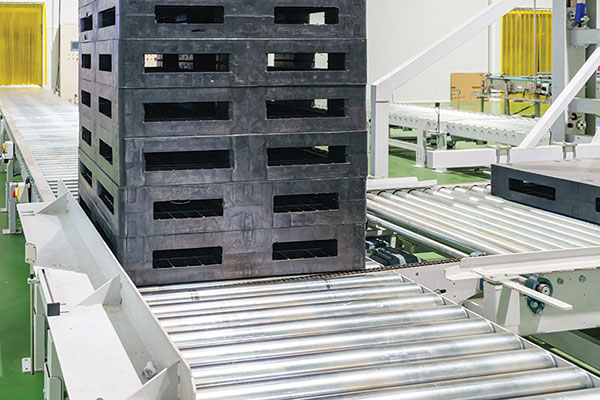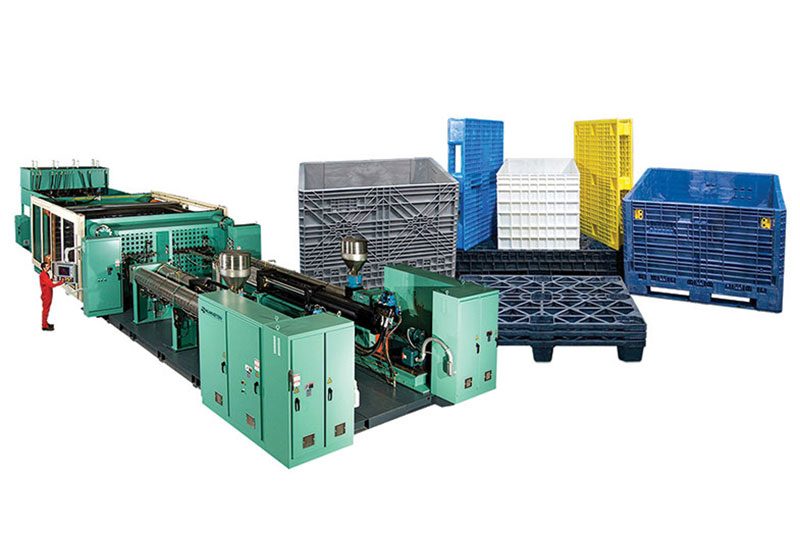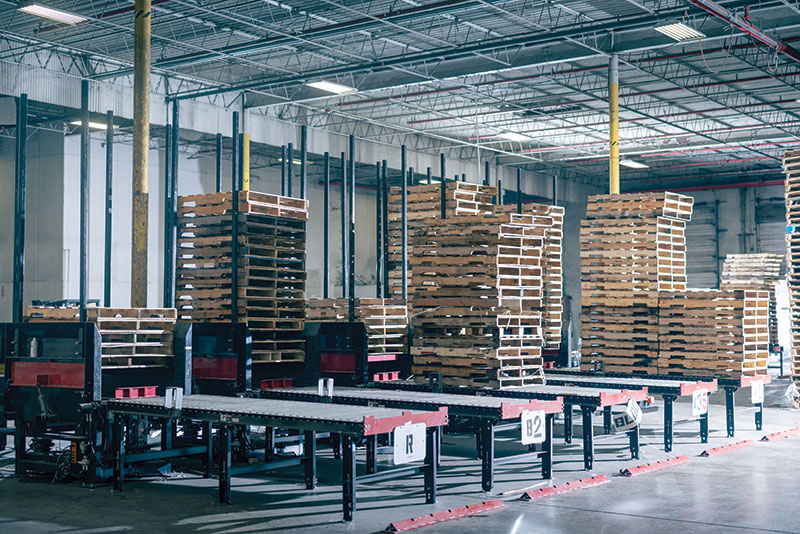Standing at The Intersection of Pallets & Automated Equipment
As more companies invest in warehouse automation, the ones that select and design their pallets early in the game are coming out winners.

Warehouse operators can invest in all the automated equipment in the world, but in the end, they’ll still need a sturdy base for storing and transporting goods across the supply chain. In nearly all cases, that means investing in pallets made of strong materials that support the goods, reduce damage, improve warehouse safety and make it easier to move goods around.
Available in various sizes and made of different materials—namely wood, plastic, metal or corrugated paper—pallets are usually 48 x 48 inches, or 4 x 4 feet, in size and designed to be lifted and moved around by forklifts, pallet jacks and other types of materials handling equipment.
More recently, pallets are being used in conjunction with automated equipment, including automatic guided vehicles (AGVs) that move goods around the warehouse; automated storage and retrieval systems (AS/RS) that store and retrieve goods in high-volume and/or high-density storage environments; and automated conveyor and sortation solutions.
“Perhaps the biggest trend this year was that respondents reported higher in-use levels for many automation categories, as well as most conventional equipment categories,” Roberto Michel writes in Modern’s “Warehouse Automation Survey: Levels and total cost of ownership (TCO) concerns on the rise” report from the February issue. “For example, the in-use level for automated storage and retrieval systems (AS/RS) reached 44%, up from 32% last year, while those using conveyor and sortation climbed to 60% this year, up from 50% last year.”

Jammed pallets can be avoided by opting for plastic, which can be constructed with more specific, consistent dimensions.
Merging Pallets and Automation
As more companies invest in warehouse automation and robotics, those advanced systems have to be able to work in harmony with pallets. If the pallets aren’t compatible with the equipment, for example, they may become damaged or jam up the machinery, which may lead to downtime and reduced throughput. Damaged pallets, incompatible pallet sizes or those that aren’t uniform in size and shape can also create challenges when merged with automated equipment.
The problem is that many companies don’t think about the marriage of pallets and automation until a problem arises.
John Vaccaro, president of Bettaway Supply Chain Services and founder of PalletTrader:
“There’s a lot to consider when moving to a system that uses pallets with automation, but most companies either disregard this, ignore it or just don’t pay attention to it at all. Companies get enthralled by the automation and the potential return on investment (ROI), but they don’t really pay attention to the pallet factor at all. This is a major oversight because without the pallet, none of the automation works.”
Stop The Jamming
Jim Boos, operations manager at Wilmington Machinery, says jammed pallets can be avoided by opting for plastic, which can be constructed with more specific, consistent dimensions.
These pallets can also be made with specific features that fit well with the automated equipment. For example, Wilmington has designed pallets that incorporate a sawtooth design. Located on the bottom of the pallet, that design is used to transport pallets throughout the warehouse on automatic chain drives.
Boos says the company is also molding RFID chips in some of its pallets, which feature a small pocket where the ID chip is placed. The pallets are then scanned as they travel through the warehouse.
Wilmington has also created pallets with hard stops on their corners that can be picked up by the automated equipment’s photo eye sensors. These are just some examples of the value that plastic pallets bring to the automated warehouse.
James Riegleman, product manager at ORBIS, says it’s important to consider the specifications and requirements of the application before investing in or renting pallets for a newly automated operation. Also, focus on the metrics that concern you the most. Less downtime? Minimizing product damage? Improved sustainability? These considerations should also be factored into your decision.

Putting pallets higher up on the priority list during an automation implementation also helps companies address the various levels of specifications and tolerances that the equipment requires.
The people component is equally as important when selecting pallets that work well with automated equipment.
James Riegleman, product manager at ORBIS:
“Identify the ‘champions’ and general stakeholders and get them involved early in the decision-making process. That will boost the long-term success of your project.”
Finally, be sure to test everything before going live with the new or upgraded system.
“We also make sure our products are tested with the automation and that there’s a good fit before rolling it out to a full system, or at a single or multiple locations,” says Riegleman, who acknowledges the fact that plastic pallets may require a higher initial investment compared to expendable wood pallets. However, he says, the ROI over the life of plastic is higher than that of wood, the latter of which has a shorter lifespan.
An Integral Part of the Automated Warehouse
A core asset in warehousing and logistics, the pallet is integral in the automation process from manual to semi-automated to fully automated facilities. Knowing this, Chad Connors, senior director of engineering, automation and tech systems for CHEP Americas, says new opportunities are emerging at the intersection of pallets and automation to increase unit load throughput, minimize product damage and expedite operations.
Chad Connors, senior director of engineering, automation and tech systems for CHEP Americas:
“Increasing levels of automation within our customer’s operations further enhances CHEP’s value in the overall process, considering the consistent quality and durability inherent in our product. These critical attributes have meaningful positive impacts on both process reliability and mean time between failure (MTBF), ultimately driving efficiencies for [companies].”
Connors says platform providers and their supply network partners should both embrace these industry-wide advancements and work together to maximize their benefits. And, companies should seek partners knowledgeable in the products and operations leveraged across their supply network, including pallets, crates and containers.
Like Riegleman, Connors says aligning with key stakeholders upfront on measures of success is also important. This may include financial factors like total cost of ownership (TCO) and ROI, or operational metrics like throughput and overall equipment effectiveness (OEE). “Employees and customers should also understand how it will impact and benefit them because open communication is an enabler to change management and the project’s ultimate success,” Connors adds.
Taking these steps early can make navigating the intersection of pallets and automation much easier. The problem is that many companies wait to enlist integration partners until the implementation stage. At that point, the design has already been completed and installation is underway or is close to completion.
Connors:
“At this stage in the project, any changes to accommodate the tolerances of a pallet can be costly to implement with retrofits. To avoid this common pitfall, involve partners early in the design phase to ensure all factors are considered and included in the solution—like pallet and unit load interactions.”
Making Pallets a Bigger Priority
Zach Gilbert, chief commercial officer at PLA Solutions, says putting pallets higher up on the priority list during an automation implementation also helps companies address the various levels of specifications and tolerances that the equipment requires. Depending on the specific machinery, the pallet supplier’s manufacturing processes may need to be “similarly sophisticated to accommodate these needs,” Gilbert says.
With their pallet management provider involved in the automation design process, companies will know how the unit load—in this case, the pallet—performs within the system. Overlooking this important step can lead to system jams, downtime and even product damage. When the pallet is not considered, system efficiencies and savings can erode pretty quickly.
Zach Gilbert:
“It comes down to understanding how the overall unit load is going to perform within these automated ecosystems and the tolerances these systems have. More than two billion pallets are flowing throughout the supply chain—all made of various materials and with a variety of specifications and tolerances. Whether pallets are wood, plastic, metal, new, pooled or recycled, all have their unique challenges in automated environments.”
To companies investing in more warehouse and DC automation in 2023, Vaccaro says understanding your product and the type of pallet that it should (or shouldn’t) be on is an important first step. Be sure to factor in weight, size and other important specifications. Then, work closely with your pallet partner and automation provider to ensure a good fit. Develop your KPIs, test the system before going live and then make the necessary adjustments as you go along.
“The key is to make sure that the pallet you’re using today will work flawlessly within the automation system,” says Vaccaro. “If it’s not, then consider what it will take to switch over to a different pallet and factor that difference into your cost calculation to justify the automation.”

Article Topics
ORBIS News & Resources
Automotive materials handling: The calm after the storm MODEX C-Suite Interview with Norm Kukuk: The Circular Economy Becomes a Core Priority ORBIS showcases packaging innovations Packaging Corner: Be open to change What’s new in totes, bins and containers? Bulk bins at GM get a makeover Extended season of giving: ORBIS donates and supports local communities on year-round basis More ORBISLatest in Materials Handling
Geek+ and System Teknik deploy PopPick solution for pharmacy group Med24.dk Beckhoff USA opens new office in Austin, Texas Manhattan Associates selects TeamViewer as partner for warehouse vision picking ASME Foundation wins grant for technical workforce development The (Not So) Secret Weapons: How Key Cabinets and Asset Management Lockers Are Changing Supply Chain Operations MODEX C-Suite Interview with Harold Vanasse: The perfect blend of automation and sustainability Consultant and industry leader John M. Hill passes on at age 86 More Materials HandlingAbout the Author
Subscribe to Materials Handling Magazine

Find out what the world's most innovative companies are doing to improve productivity in their plants and distribution centers.
Start your FREE subscription today.
April 2024 Modern Materials Handling

Latest Resources










